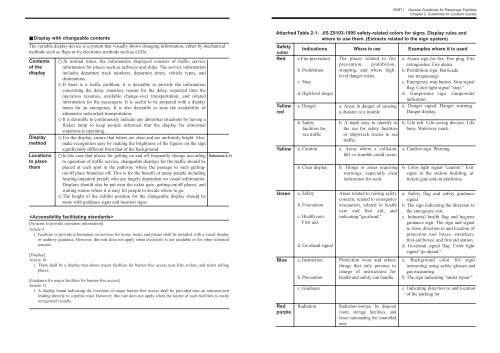Guidelines to Improve Barrier-Free Access for Public Transport ...
Guidelines to Improve Barrier-Free Access for Public Transport ...
Guidelines to Improve Barrier-Free Access for Public Transport ...
- No tags were found...
You also want an ePaper? Increase the reach of your titles
YUMPU automatically turns print PDFs into web optimized ePapers that Google loves.
PART IGeneral <strong>Guidelines</strong> <strong>for</strong> Passenger FacilitiesChapter 2. <strong>Guidelines</strong> <strong>for</strong> Location GuidesDisplay with changeable contentsThe variable display device is a system that visually shows changing in<strong>for</strong>mation, either by mechanicalmethods such as flaps or by electronic methods such as LEDs.Contentsof thedisplayDisplaymethodLocations<strong>to</strong> placethemAt normal times, the in<strong>for</strong>mation displayed consists of traffic servicein<strong>for</strong>mation <strong>for</strong> places such as railways and ships. The service in<strong>for</strong>mationincludes departure track numbers, departure times, vehicle types, anddestinations. If there is a traffic problem, it is desirable <strong>to</strong> provide the in<strong>for</strong>mationconcerning the delay situation, reason <strong>for</strong> the delay, expected time theoperation resumes, available change-over transportation, and relatedin<strong>for</strong>mation <strong>for</strong> the passengers. It is useful <strong>to</strong> be prepared with a displaymenu <strong>for</strong> an emergency. It is also desirable <strong>to</strong> state the availability ofalternative networked transportation. It is desirable <strong>to</strong> continuously indicate any abnormal situations by having aflicker lamp <strong>to</strong> keep people in<strong>for</strong>med that the display <strong>for</strong> abnormalsituations is operating. For the display, ensure that letters are clear and are uni<strong>for</strong>mly bright. Also,make recognition easy by making the brightness of the figures on the signsignificantly different from that of the background. In the case that places <strong>for</strong> getting on and off frequently change according<strong>to</strong> operation of traffic service, changeable displays <strong>for</strong> the traffic should beplaced at each spot in the pathway where the passage <strong>to</strong> such gettingon/offplace branches off. This is <strong>for</strong> the benefit of many people includinghearing-impaired people who are largely dependent on visual in<strong>for</strong>mation.Displays should also be put near the ticket gate, getting-on/off places, andwaiting rooms where it is easy <strong>for</strong> people <strong>to</strong> decide where <strong>to</strong> go. The height of the exhibit position <strong>for</strong> the changeable display should besame with guidance signs and location signs.Reference 2-11[Systems <strong>to</strong> provide operation in<strong>for</strong>mation]Article 91. Facilities <strong>to</strong> provide in<strong>for</strong>mation on services <strong>for</strong> trains, boats, and planes shall be installed with a visual displayor audi<strong>to</strong>ry guidance. However, this rule does not apply when electricity is not available or <strong>for</strong> other technicalreasons.[Display]Article 101. There shall be a display that shows major facilities <strong>for</strong> barrier-free access near lifts, <strong>to</strong>ilets, and ticket sellingplaces.[Guidance <strong>for</strong> major facilities <strong>for</strong> barrier-free access]Article 111. A display board indicating the locations of major barrier-free access shall be provided near an entrance/exitleading directly <strong>to</strong> a public road. However, this rule does not apply when the layout of such facilities is easilyrecognized visually.Attached Table 2-1:SafetycolorRedYellowredYellowGreenBlueRedpurplea Fire preventionb. Prohibitionc. S<strong>to</strong>pd. High-level dangerJIS Z9103-1995 safety-related colors <strong>for</strong> signs. Display rules andwhere <strong>to</strong> use them. (Extracts related <strong>to</strong> the sign system)Indications Where <strong>to</strong> use Examples where it is useda. Dangerb. Safetyfacilities <strong>for</strong>sea traffica. Cautiona. Safetyb. Evacuationc. Health care.First aid.d. Go ahead signala. Instructionb. Precautionc. GuidanceRadiationThe places related <strong>to</strong> fireprevention, prohibition,s<strong>to</strong>pping, and where highleveldanger exists.a. Areas in danger of causinga disaster or a troubleb. A mark easy <strong>to</strong> identify inthe sea <strong>for</strong> safety facilitiesor shipwreck rescue in seatraffic.a. Areas where a collision,fall, or stumble could occur.b. Clear display b. Things or areas requiringwarnings, especially clearindications <strong>for</strong> such.Areas related <strong>to</strong> raising safetyconcern, related <strong>to</strong> emergencyevacuation, related <strong>to</strong> healthcare and first aid, andindicating "go ahead."Protection wear and othersthings that only persons incharge of instructions <strong>for</strong>health and safety can handle.Radiation-iso<strong>to</strong>pe. Its disposalroom, s<strong>to</strong>rage facilities, andfence surrounding the controlledarea.a. Alarm sign <strong>for</strong> fire. Fire plug. Fireextinguisher. Fire alarm.b. Prohibition sign. Barricade (no trespassing)c. Emergency s<strong>to</strong>p but<strong>to</strong>n. S<strong>to</strong>p signalflag. Color light signal "s<strong>to</strong>p."d. Gunpowder sign. Gunpowderindication.a. Danger signal. Danger warning.Danger display.b. Life raft. Life-saving devices. Lifebuoy. Waterway mark.a. Caution sign. Warning.b. Color light signal "caution." Exitsigns in the station building, attickets gate and on plat<strong>for</strong>ms.a. Safety flag and safety guidancesignal.b. The sign indicating the direction <strong>to</strong>the emergency exit.c. Industrial health flag and hygieneguidance sign. The sign and signal<strong>to</strong> show direction <strong>to</strong> and location ofprotection <strong>to</strong>ol boxes, stretchers,first-aid boxes, and first aid station.d. Go-ahead signal flag. Color lightsignal "go ahead."a. Background color <strong>for</strong> signsinstructing using safety glasses andgas measuring.b. The sign indicating "under repair."c. Indicating direction <strong>to</strong> and locationof the parking lot

















